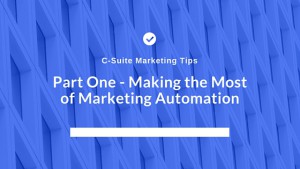The first in a 2-part executive interview with Brad Banyas, Founder and CEO, OMI
Marketing automation is an approach that allows companies to streamline, automate, and measure marketing tasks and workflows, so they can increase operational efficiency and grow revenue faster. Technical automation combined with consumer-based strategies nurture prospects with highly personalized content while back end systems help keep customers engaged and coming back for more. This type of automation typically generates significant new revenue for companies and provides an excellent return on investment.
How can you make the most of marketing automation?
That’s what I asked Brad Banyas, founder and CEO of OMI, a leading cloud-based customer communication management service and platform provider. OMI delivers cost-effective solutions for marketers and brand managers to automate and streamline their marketing efforts and better connect with customers through their 366 Degrees platform. The company boasts a growing roster of customers that include financial services, healthcare, manufacturing and nonprofit verticals.The systems and products surrounding marketing automation have grown tremendously, and are no longer within reach to only large, well-funded large enterprise companies. Many small and mid-sized companies are finding the power of marketing automation, and as a result the playing field has begun to level. But even still, there are many challenges to effective marketing automation, however; and CMOs from all industries are looking to make better use of their marketing investment. Lead acquisition and nurturing, customer lifetime value, and perceived market presence all make for unique and evolving challenges. Clearly, no one-size-fits-all approach will work for every organization.
What do you think the biggest challenge is that companies face today when it comes to marketing automation?
There are two or three pretty succinct areas. The first area is really content. When running an email campaign, for example, you need to think through the content from an automation perspective. What touch point am I communicating to? Is it mobile, is it email, is it online, is it a landing page, or is it a video? The planning around that takes a lot more strategic thought that most people think about. For example, a lot of people are using marketing automation or sales automation tools, but you can tell based on what they put out there that they haven’t really thought through the content. They’re writing, “Hit me back,” and things that are really informal; and if you have a relationship with someone that’s okay, but if not, the content is probably turning them off. Instead, you should be looking closely at where that person is in the buying phase…or even if they are in a buying phase at all…before you try to get personal and build that relationship.
So what you are saying is that customers don’t respond to simply any content, they respond instead to more meaningful and relevant content?
I think from a content perspective, it takes a little bit more thought than simply driving an email newsletter out or pitching a webinar. Those are traditional things that you can certainly automate today. It’s easy to set up a campaign for a webinar, give the email notice, give the reminders, and do simple things like follow up after webinar and put attendees into some nurture campaign. Those are pretty straightforward. But it’s what you do with that process and the types and timing of the content you provide that is often the missing ingredient to success ultimately.
You say that there is often a disconnection between Marketing and Sales that ultimately limits companies’ success. Can you describe that disconnect and what can be done about it?
Many times marketing and sales are isolated culturally and procedurally, and the misalignment of sales and marketing is one of the biggest problems we see out there today. Most of the sales teams are in CRMs or databases that are focused around opportunity or forecasting, and they don’t always see the content that marketing is doing to drive the products and services. This results in a real lack of visibility across the two groups when instead they really should be in very close synchronization.
Why is this misalignment happening and what can be done about it?
I think it’s all about the cadence of content. Salespeople are looking for leads that are further along the buying path versus what might be considered a qualified lead from a strictly marketing point of view. Marketing is up on the analytical reporting; the clicks-throughs and the page views, but those activities do make for a potential interest or potential engagement from a sales point of view. In other words, just because someone’s clicked on an email ten times doesn’t mean they’re necessarily a qualified lead. So trying to define what a qualified lead is from a marketing perspective and what a qualified lead is from a sales perspective is a big disconnect for many organizations.
What we do with 366 Degrees is address those areas and provide the marketing and sales teams with e visibility into the activities at any point in the sales funnel. Whether you’re in your CRM or you subscribe for activity-type notifications, this at least it gives both marketing and sales basic visibility into what the prospect or lead is actually engaging with and about. From there both sales and marketing can make a call on what the best next steps should be in terms of moving that prospect along in the sales cycle.
